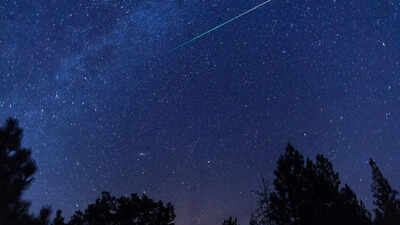The annual Leonid meteor shower provides a vivid reminder of Earth’s ongoing journey through the remnants of ancient comets, offering both amateur stargazers and professional astronomers an opportunity to observe a spectacular natural phenomenon. Each year, fragments of cosmic dust and ice left behind by the periodic comet 55P/Tempel‑Tuttle enter Earth’s atmosphere at tremendous speeds, creating luminous streaks that briefly illuminate the night sky. The 2025 peak, projected for the overnight hours of November 16–17, presents a favourable window for observation due to a thin crescent moon and a dark sky in many regions. Space.com outlines precise timing, radiant location, and visibility conditions, providing guidance for optimising viewing experiences while also contextualising this year’s meteor rates in relation to past Leonid displays.
How a comet creates the annual Leonid shower and where it comes from
The Leonids originate from debris trails left by the periodic comet 55P/Tempel‑Tuttle, which follows an elliptical orbit intersecting Earth’s path approximately every 33 years. As Earth passes through these dust streams, particles enter the atmosphere at velocities approaching 70 km per second, producing brief, bright streaks across the sky. The meteors appear to radiate from a point in the constellation Leo, giving the shower its name. The density of the debris stream varies annually depending on the specific trail Earth intersects, which directly influences the expected number of visible meteors. In some years, the Leonids have produced spectacular meteor storms exceeding hundreds or even thousands of meteors per hour, while in more typical years, observers may see a modest five to fifteen meteors per hour. The 2025 forecast anticipates relatively moderate activity, but the high velocity of individual meteors ensures they remain visually striking, sometimes leaving temporary glowing trails or generating brief fireballs that stand out against the night sky.
When, where and how to observe the Leonid meteor shower: Optimising your sky‑watching session
Observing the Leonid meteor shower successfully requires careful attention to timing, location, and preparation. The optimal period in 2025 is during the pre-dawn hours of November 17, when the constellation Leo rises higher in the sky and the crescent moon produces minimal light interference. Choosing a location away from urban lights and with a clear view of the horizon increases the likelihood of spotting meteors. Viewers should allow their eyes to adapt to the darkness for at least twenty to thirty minutes, and adopt a relaxed posture to take in a broad portion of the sky rather than focusing only on the radiant. Binoculars or telescopes are not necessary, as meteors span wide angles and are visible to the naked eye. Weather conditions, including cloud cover and fog, can affect visibility, so checking the local forecast is recommended.
- Optimal viewing window: Pre-dawn hours of November 17, 2025
- Radiant location: Constellation Leo, rising higher as the night progresses
- Moon phase: Thin crescent, minimal light interference
- Observation site: Dark locations away from urban light pollution, with open horizon
- Viewing method: Lie back or use a reclining chair to see a wide portion of the sky
- Eye adaptation: Allow 20–30 minutes for eyes to adjust to darkness
- Equipment: No telescope or binoculars required; meteors are visible to the naked eye
- Weather considerations: Clear skies preferred; cloud cover or fog may reduce visibility
What observers can expect from this year’s Leonids
While historic Leonid storms have produced extraordinary meteor counts, the 2025 display is expected to be more subdued. Under ideal conditions, observers may witness ten to fifteen meteors per hour. Despite the lower numbers, the high velocity of Leonid meteors means that even modest displays can appear sharp and luminous, with some particles leaving visible smoke trails that persist for several seconds. Larger meteoroids in the debris stream occasionally produce fireballs, which are significantly brighter than typical meteors and can draw attention across the entire sky. These events are sporadic, making each occurrence notable for enthusiasts. The combination of fast movement and the potential for rare bright events ensures that the 2025 Leonids remain an engaging and visually appealing phenomenon, particularly for viewers in locations with dark, unobstructed skies and minimal light interference.
How scientists use the Leonid meteor shower for research
Leonid meteor showers have been observed for centuries, with notable storms recorded in the 19th century that attracted widespread attention and contributed to the early scientific study of meteors. Modern observation of the Leonids provides opportunities for both public engagement and scientific inquiry. Amateur astronomers can record meteor counts, durations, and trajectories, contributing to databases that improve understanding of debris stream density and evolution over time. The variation in annual meteor rates reflects subtle shifts in the comet’s debris field and Earth’s orbital path, offering insight into celestial mechanics and the dynamics of meteoroid streams. Observations of Leonid fireballs also inform atmospheric studies, as the interaction of high-velocity meteoroids with the upper atmosphere generates ionised trails that can be analysed using radar or photographic techniques. In 2025, the favourable timing, relatively dark skies, and accessible viewing hours create a unique opportunity for both educational programmes and citizen science initiatives, allowing participants to observe, record, and appreciate the mechanisms of this recurrent astronomical phenomenon.
How meteor showers connects observers to the broader cosmos
Beyond their scientific value, meteor showers such as the Leonids serve to connect communities to the wider cosmos. By encouraging night‑sky observation and raising awareness of orbital mechanics, these events foster curiosity and engagement with astronomy, often inspiring further study of planetary systems, comets, and meteor science. The 2025 Leonids offer a practical example of how a recurring celestial event can combine observational accessibility with meaningful insight into the solar system, demonstrating the continuing interplay between Earth and the trails of ancient comets.Also Read | New warrior-like crocodile relative fossil found in Brazil reshapes Triassic predator evolution Go to Source



